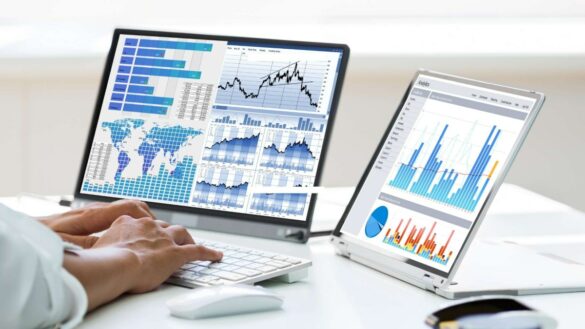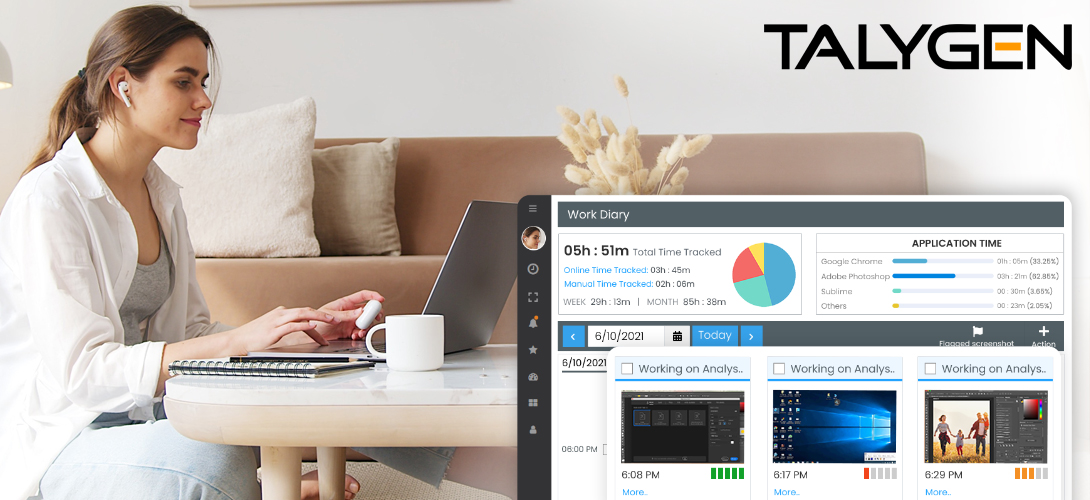The term"employee monitoring software" is used to refer to the software that companies use to monitor the activities of their employees while they work. Employers are able to collect data regarding a wide range of variables related to employee behavior. This can include internet use, application use keyboard strokes, screenshots, and keystrokes. Monitoring software for employees serves an primary objective to improve employee productivity, ensure that the company's policies are followed, protect sensitive info, and deal with any security issues. There are a variety of factors to consider when choosing an employee-monitoring software. Be aware of these important factors: Features- Determine the features you need in accordance with the needs of your company. The most common features are monitoring of activity, blocking websites keystrike recording, tracking of application usage along with email monitoring and reports generation. Make sure you prioritize features according to the goals of your monitoring.
Compliance and Privacy: Ensure the software complies with the ethical and legal guidelines regarding employee monitoring. Learn about the applicable laws and regulations in your area. Find software that offers flexible and transparent settings to ensure that privacy rights of employees are respected.
User-Friendliness - Take into account the accessibility of the software and ease of use. A user-friendly interface and straightforward set-up process can save you time and make the process easier to implement. Look for customizable dashboards and intuitive reporting tools that let you easily browse and analyze the data you have collected.
Integrity and compatibility - Check whether the program is compatible with your current infrastructure and other systems you use. These include operating systems and email clients. The software that you are compatible with guarantees uninterrupted monitoring and doesn't disrupt day-today business.
Data Security- Examine the software's security features to protect the data collected. Data encryption, storage in a secure environment access control, as well as conformity to security requirements are all essential. Check that the software company is well-known for its data protection records and has strong security measures.
Scalability- Think about the capacity of the software in order to accommodate your company's expansion. If you plan on expanding your staff or adding new locations, you should choose a software that will easily scale to meet your changing needs.
Analytics and Reporting - Take a look at the features of the software that allow reports. You should look for features that give comprehensive insights into the productivity of employees, their the allocation of time, and other trends. Customizable reports and analytics assist you in making educated decisions and determine areas of improvement.
Customer Support: Evaluate the quality of support provided by the software company. Examine their responsiveness, availability and level of technical support. A competent customer support team will be able to provide immediate assistance to any issue that might arise.
Cost- Think about the pricing structure of the program, whether it is a one-time payment or subscription-based. Understanding the pricing structure and any additional costs like support, updates or extra features is crucial. Make sure you are budgeting in line with the value and features provided.
Transparency and employee communication Be clear with your employees on the introduction of software for monitoring. Transparently communicate the purpose the work scope, and expectations with respect to the monitoring. Be sure they know their rights to privacy and discuss any concerns.
Consider these factors to make the right decision and choose the employee monitoring software that meets your company's standards while also respecting the employee's privacy. Have a look at the recommended time tracking monitoring services for website recommendations.

What Are The Features Of The Employee Monitoring Software? And What Are The Differences Between Them?
Employee monitoring software includes a wide range of features designed to track and analyze employee actions. Different software options may provide different features, but these are the most popular. It provides a comprehensive overview of how employees spend their time at work.
Keystroke Logging Keystroke logs record every keystroke performed by employees. It helps find productivity bottlenecks, as well as detect unauthorized actions and gather evidence for investigations.
Screenshots or Screen Recording - Some software takes regular screenshots from computer screens, whereas others record their screens in real-time. This feature is useful in monitoring productivity, ensuring compliance and troubleshooting problems.
Internet Usage Tracking This function records employees' online activities, such as the websites they visit, their search queries, downloads, etc. It is used to monitor excessive internet browsing that is not related to work, security risks, or policy violations.
This feature allows you to track the applications that employees use at work. It assists in identifying inappropriate and excessive use of apps by providing insight into the applications frequently used.
Email Monitoring- Email monitoring lets employers monitor employee emails, including sent and received messages, attachments, and email content. It helps to ensure compliance with policies of the company, stop data leakage and to examine any suspicious behavior.
Document and file tracking This feature monitors the changes in the form of transfers, modifications, and additions to files. It can help protect sensitive information and monitor collaboration between documents and make sure that data security is in compliance with guidelines.
Remote Monitoring is a feature that lets employers monitor their employees, regardless of whether they work from a distance or at varying places. It allows employers to track their activities and monitor productivity regardless of their physical location.
Productivity Analysis Software used for employee monitoring often has productivity analysis tools that provide information on the allocation of time and patterns of work. These analyses enable the analysis of areas that can be improved, and also help to optimize workflow.
Analytics and ReportingThe robust analytics and reporting tools generate elaborate reports and visuals based on the collected data. These reports offer valuable insight into the performance of employees in time management, as well as the allocation of resources.
Software that offers features to ensure compliance and management of policies can help ensure that an organization's rules and regulations are adhered to. Employers are able to define and enforce policy related to the use of computers Internet access, acceptable use of computers and data security.
Alerts/Notifications: Notifications and alerts inform employers or managers whenever certain events or activities occur. They could alert them to excessive internet usage, attempts to access restricted sites, or unsettling behavior.
It is crucial to recognize that these features may differ dependent on the software you choose. When choosing a software, be sure that the features you choose are in line with your monitoring goals as well as complying with the ethical or legal guidelines applicable to your jurisdiction. Take a look at the top rated employee monitoring company for website advice.

What Software Is Used To Monitor Employee Performance? How Does It Adhere To Compliance And Privacy Law?
The software's ability to adhere to the privacy and compliance laws is critical. Although the specific legal requirements may differ based on jurisdiction however, there are some commonly used methods that employee monitoring software adheres compliance and privacy law. Consent & NoticeA majority of areas require employees to provide an informed consent and receiving prior notice of any monitoring activities. The software used to monitor employees usually has features that enable employers to clearly explain their monitoring policy to employees. This could include providing written notices, seeking consent via consent forms or even implementing an employee handbook which outlines monitoring practices.
Transparent Monitoring Polices- Employee monitoring tools promote transparency. They ensure that employees know what kinds of information are being collected and for what purpose, as well being aware of the extent of monitoring. Employees can better understand their privacy rights and the limits of monitoring when policies are precise and complete.
Data minimization is typically employed by employee monitoring software to ensure compliance with privacy laws. The software stores and collects only what is necessary, and avoiding irrelevant or excessive data. By restricting data collection to what is necessary to monitor purposes, this software reduces privacy risk and promotes compliance.
Anonymization and Aggregation- Certain software that monitors employees collects and anonymizes data to safeguard privacy of employees further. Data collected is anonymized to eliminate personally identifiable information. Aggregation makes use of data from many employees to generate insights for a larger group without identifying any individuals.
Secure Data Storage & Encryption - Software for monitoring employees places a high priority in the protection of data collected. Secure encryption and storage of data is used to safeguard data against unauthorized access or accidental disclosure. It is crucial to secure data in transit as well as in storage.
Access Controls and Restricted permissions Software for monitoring employees offers access controls with granularity to ensure compliance. This allows employers to limit access to monitoring information only to authorized individuals who require the data for legitimate purposes, such as HR personnel or designated administrators.
Employee RightsRespecting the rights of employees means adhering to compliance and privacy laws. Software used to monitor employees often includes features that allow employees to access their monitoring records as well as request corrections and submit complaints. This empowers employees to assert their rights and pursue remedies in the event of privacy breaches.
Compliance with Data Protection Regulations - Employee monitoring software was created to be in compliance with regulations governing data protection, such as the General Data Protection Regulation in the European Union (GDPR) or the California Consumer Privacy Act in the United States (CCPA). The way to achieve compliance is by taking the appropriate safeguards to protect personal data, respecting data subjects rights, and ensuring the lawful use of data.
While monitoring employees can aid organizations comply with laws and regulations however, they must also consult with lawyers and remain up to date on local regulations and laws. A comprehensive approach to complying with compliance and privacy legislation is required, which goes beyond the software. It includes explicit policies, as well as employee education and ongoing monitoring. Take a look at the recommended employee monitoring company for more info.
